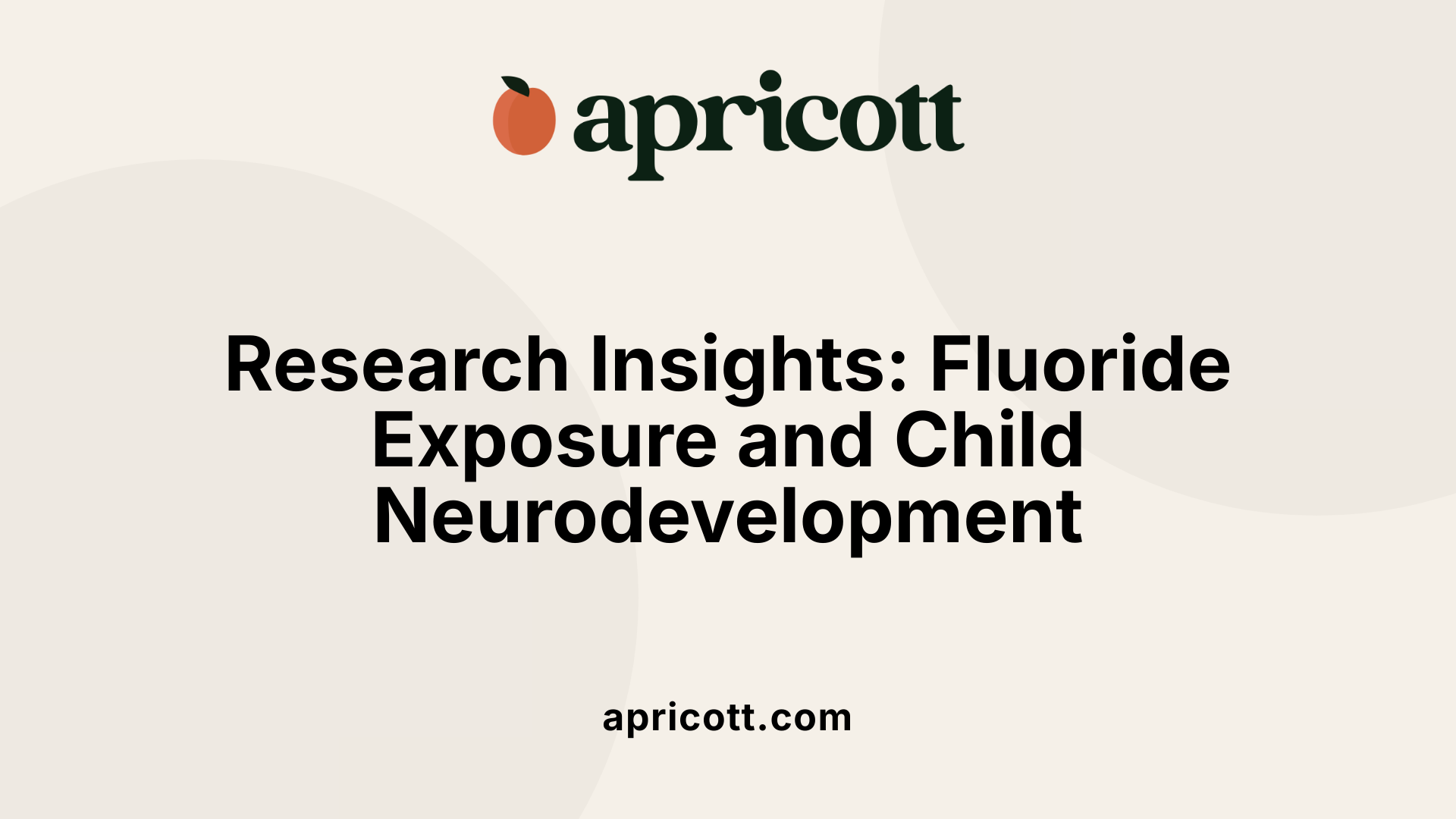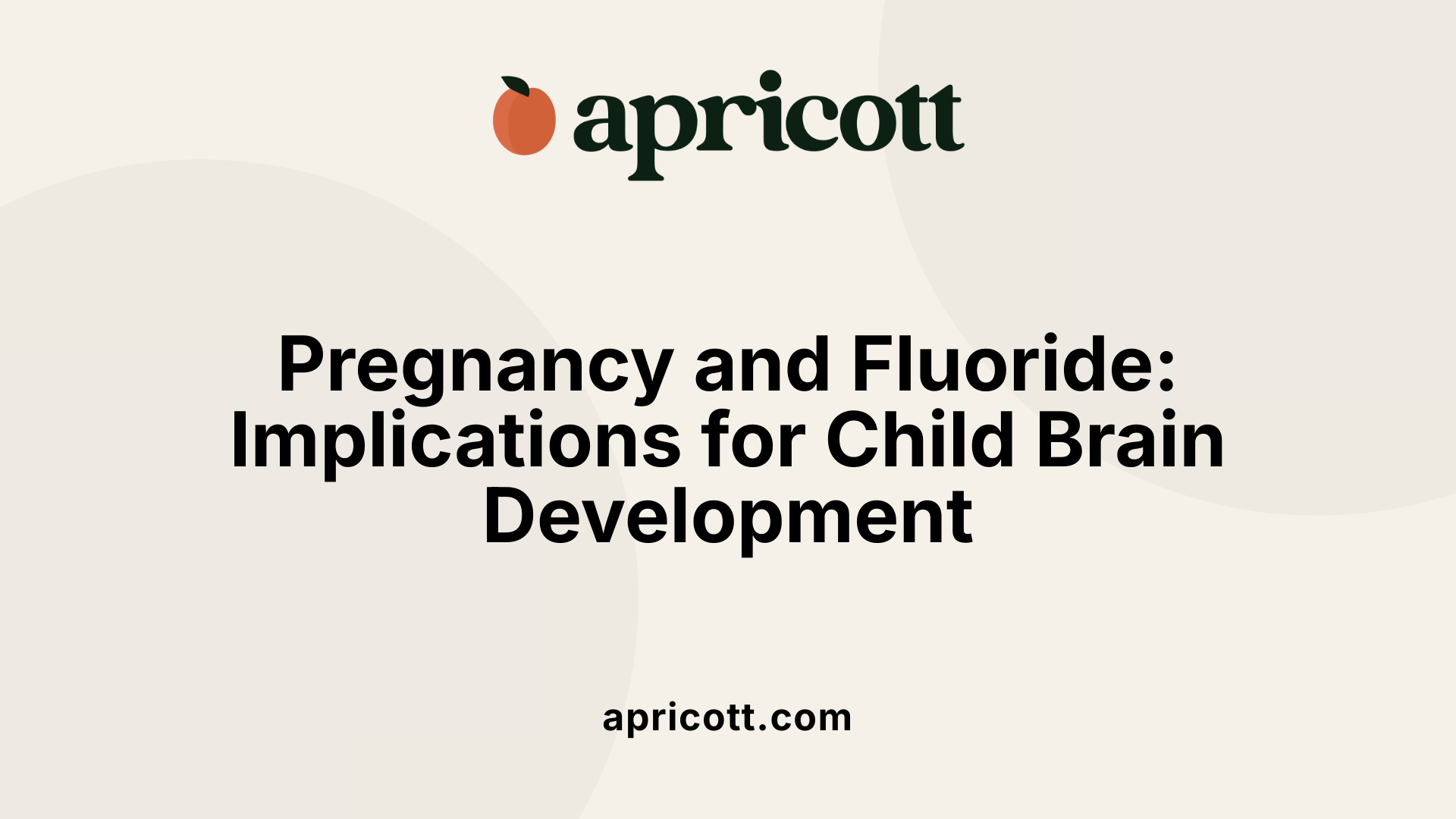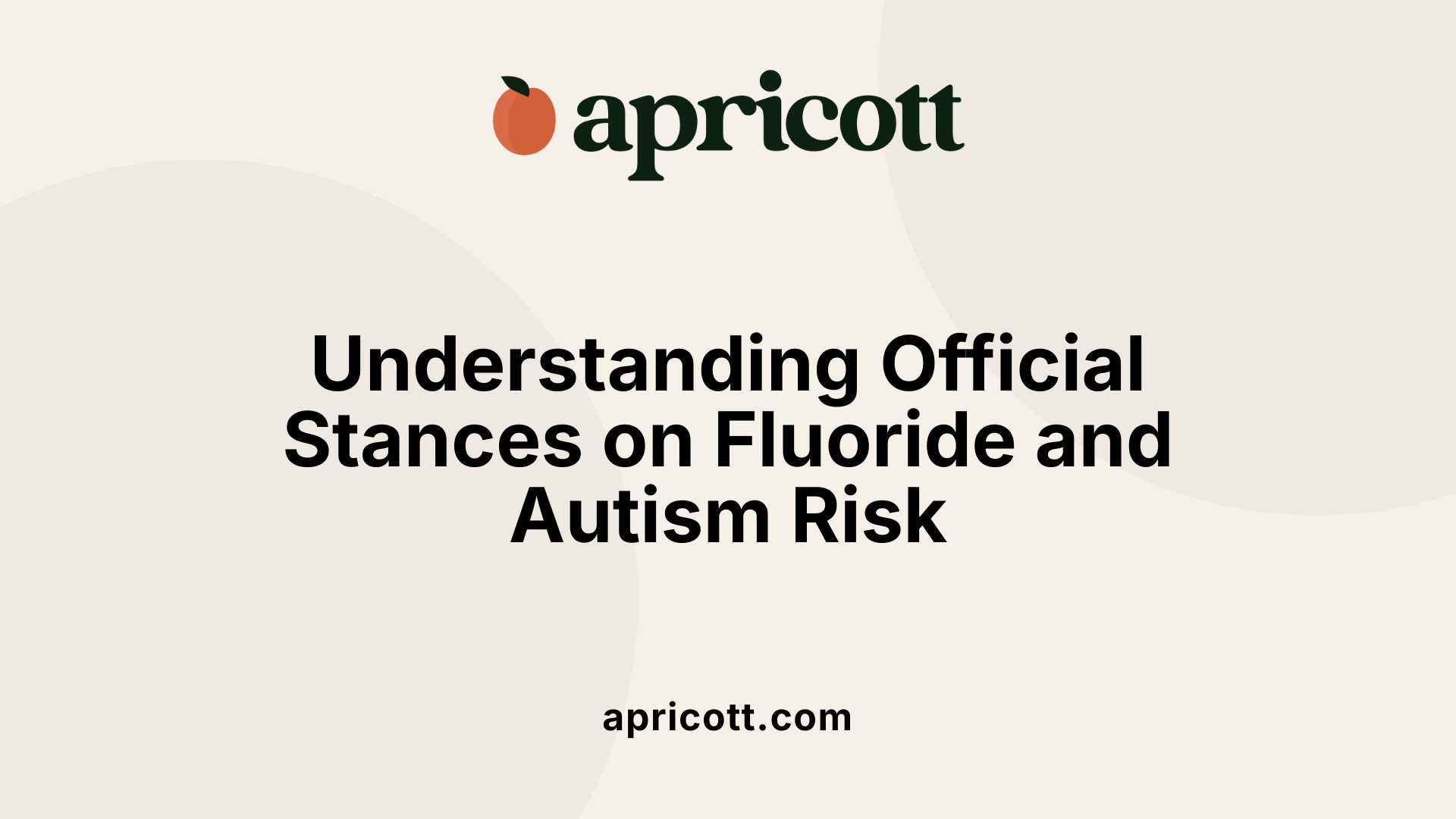July 22, 2025
Unraveling the Complexities of Fluoride and Autism Risk
The question of whether fluoride exposure causes autism spectrum disorder (ASD) has garnered significant public attention. While fluoride is widely used for dental health, concerns about its potential neurotoxic effects and links to neurodevelopmental issues have prompted extensive scientific investigation. This review synthesizes current research findings, biological mechanisms, and official guidelines to clarify what is known about fluoride's impact on autism and neurodevelopment.

Research suggests that fluoride could influence brain development through several biological pathways. One primary concern is that fluoride can cross both the placental barrier during pregnancy and the blood-brain barrier in children, allowing it to accumulate in brain regions involved in learning and memory.
Once in the brain, fluoride may induce various harmful biochemical and structural changes, including lipid peroxidation, which damages cell membranes, and neuroinflammation, which can harm neural tissues. These effects can lead to neuronal damage that disrupts normal brain functions.
Fluoride exposure is also linked to mitochondrial dysfunction. Mitochondria are vital for energy production, and fluoride may damage mitochondrial DNA, impair mitochondrial biogenesis, and reduce the efficiency of energy generation. This leads to increased oxidative stress, where harmful free radicals accumulate, further damaging neural cells.
Additionally, fluoride can interfere with neurotransmitter systems, alter ion channel operation, and disrupt synaptogenesis—the formation of synapses essential for neural communication. It can affect synaptic proteins like PSD-95 and synaptophysin, which are important for maintaining synaptic integrity.
Beyond direct neural effects, fluoride's impact on the thyroid gland could indirectly impair neurodevelopment, since thyroid hormones are critical for brain growth. Epidemiological studies also suggest that high fluoride exposure correlates with cognitive deficits, including lowered IQ scores in children.
Overall, these proposed mechanisms highlight how fluoride toxicity might influence neurodevelopment through cellular damage, disrupted energy metabolism, altered neural signaling, and hormonal imbalances, raising concerns about its safety at high exposure levels.
 Numerous studies across different countries have explored the potential connection between fluoride exposure and neurodevelopmental outcomes in children. A common finding in the literature is that higher fluoride levels in drinking water are associated with reductions in IQ scores.
Numerous studies across different countries have explored the potential connection between fluoride exposure and neurodevelopmental outcomes in children. A common finding in the literature is that higher fluoride levels in drinking water are associated with reductions in IQ scores.
Research, especially from China, has reported that when children are exposed to fluoride concentrations exceeding 1.5 mg/L, their IQ tends to be lower compared to those exposed to lower fluoride levels. Meta-analyses compiling data from multiple international studies consistently show an inverse relationship between fluoride levels—measured in water and urine—and neurodevelopmental metrics.
Evidence indicates that children with higher fluoride exposure may exhibit modest drops in IQ scores, averaging around 4.7 points in high-exposure groups compared to lower exposure references. These findings suggest a potential neurotoxic effect of fluoride, especially at elevated concentrations.
Many studies observe a dose-response pattern, where IQ declines become more pronounced as fluoride levels increase, particularly above 2 mg/L. However, the data at fluoride concentrations at or below current public health guidelines (e.g., 0.7 mg/L in water) are less clear, with some studies showing no significant effects.
Notably, the research faces challenges such as heterogeneity in study design, populations, and measurement methods. Many studies are observational, which limits their ability to confirm causality. Potential biases and confounding factors—like socioeconomic status, exposure to other neurotoxins, and nutritional factors—also complicate interpretations.
While evidence points toward a possible association, definitive conclusions require further well-designed, prospective research that examines low-level fluoride exposure over longer periods.
| Study Type | Main Findings | Limitations | Geographic Focus | Sample Size |
|---|---|---|---|---|
| Cross-sectional | Inverse IQ-fluoride relationship | Heterogeneity, bias | China, US, others | Varies |
| Meta-analyses | Consistent IQ reduction with higher fluoride | Confounding factors | Global | Multiple |
| Cohort | Associations at higher fluoride levels | Limited at low levels | Various | 200+ mothers |
For further insights, search terms such as "epidemiological studies fluoride neurodevelopment" can yield detailed scientific assessments on this topic.

Emerging research suggests that fluoride exposure in utero might negatively influence a child's brain development. Several studies indicate that higher maternal fluoride levels, measured through urine tests during pregnancy or estimated dietary intake, are associated with lower intelligence quotient (IQ) scores in children. This effect has been particularly noted in boys, who showed more pronounced cognitive deficits.
In addition to cognitive impacts, elevated prenatal fluoride levels have been linked to increased neurobehavioral issues, including higher levels of anxiety, somatic complaints like headaches or stomachaches, and behaviors associated with autism spectrum disorder (ASD). Some systematic reviews estimate a moderate level of confidence that drinking water with fluoride concentrations exceeding 1.5 mg/L correlates with reduced IQ, though the commonly used fluoridation level of around 0.7 mg/L's effects are still under investigation.
One notable study from the Keck School of Medicine of USC analyzed over 220 mother-child pairs. It found that children whose mothers had urinary fluoride levels indicating higher prenatal exposure were 1.83 times more likely to exhibit clinically significant behavioral problems. These findings point to possible risks associated with fluoride intake during pregnancy.
While the available evidence raises concerns, it is important to stress that research is ongoing, and causality has not been definitively established. More detailed studies are needed to fully understand the potential long-term effects of low to moderate fluoride exposure in utero.
| Fluoride Level in Water | Associated Risks | Notes |
|---|---|---|
| Above 1.5 mg/L | Reduced IQ, neurobehavioral problems | Moderate confidence from systematic reviews |
| Around 0.7 mg/L | Uncertain effects | Typical fluoridation level |
This area of research underscores the importance of monitoring fluoride exposure during pregnancy to better understand its possible influence on child neurodevelopment.

To date, there is no conclusive scientific proof that fluoride exposure directly causes autism spectrum disorder (ASD). Most prominent health organizations, including the CDC and WHO, continuously review extensive research to assess safety. They generally agree that when fluoride is used at recommended levels, it is safe and effective for preventing tooth decay.
However, emerging studies suggest potential neurotoxic effects of fluoride, such as mitochondrial dysfunction, oxidative stress, inflammation, and immune system disturbances. These processes are also observed in individuals with ASD, prompting scientists to explore possible connections.
Some large-scale research analyses have indicated associations between prenatal fluoride exposure and increased risks of neurodevelopmental issues, including behavioral problems and reduced IQ in children. For instance, a study from USC found that higher fluoride levels during pregnancy related to greater behavioral challenges in children. These include emotional reactivity, somatic complaints like headaches, and anxiety — symptoms that overlap with behaviors seen in autism.
In addition, fluoride has been shown to accumulate in brain regions such as the pineal gland, which may influence sleep patterns and developmental processes crucial during early childhood. Despite these findings, it is important to emphasize that correlation does not equate to causation. Overall, the consensus remains that more rigorous research is necessary to establish any causal relationship.
While some research suggests possible risks, existing regulatory limits are designed to maintain fluoride safety for the general population. Current guidelines aim to balance benefits for dental health with potential risks, setting exposure thresholds that are well within safety margins.
In summary, although some studies highlight areas for further investigation, the majority of scientific evidence currently does not support fluoride as a cause of ASD but underscores the need for continued research into neurodevelopmental effects.

Currently, no official health guidelines or authoritative conclusions have explicitly linked fluoride exposure to autism spectrum disorder (ASD). Major health organizations such as the Centers for Disease Control and Prevention (CDC), the American Dental Association (ADA), and the American Academy of Pediatrics Development (AAPD) maintain that the available scientific evidence does not establish a direct connection between fluoride intake and autism risk.
These organizations emphasize that fluoride, when used properly at recommended levels, is safe and effective for preventing dental caries. The guidelines they promote focus on maintaining optimal fluoride levels in community water supplies and dental products, balancing benefits in oral health against potential risks.
Recent research, however, has begun to explore potential associations between prenatal fluoride exposure and increased risks of neurobehavioral issues in children, including emotional reactivity, anxiety, and somatic complaints. For example, a study from USC indicated that higher fluoride levels during pregnancy might be linked to behavioral problems, but the evidence is preliminary and not conclusive.
While these emerging findings prompt further investigation, they have not resulted in any formal revision of current guidelines. The scientific community still regards fluoride as generally safe within existing exposure limits. Nonetheless, ongoing research and debates highlight the importance of continuing careful monitoring and review of new evidence.
In summary, the current stance of major health authorities is that fluoride use, at recommended doses, does not pose a confirmed risk for autism. The topic remains an area of active research, emphasizing the need for ongoing assessment and balanced public health messaging.
In summary, while some studies raise concerns about fluoride's neurotoxic potential and its possible association with developmental issues like ASD, the current scientific consensus does not confirm a causal relationship. Biological mechanisms suggest that fluoride could impact brain development under certain conditions, especially in vulnerable populations such as pregnant women and children. Epidemiological data demonstrate associations at high exposure levels but do not establish causality. Public health authorities maintain that fluoride, used within regulated limits, provides significant dental health benefits and has an acceptable safety profile. Ongoing research continues to explore these complex interactions, emphasizing the need for high-quality, longitudinal studies to clarify low-level exposure risks. Careful monitoring and adherence to guidelines remain essential as science progresses.